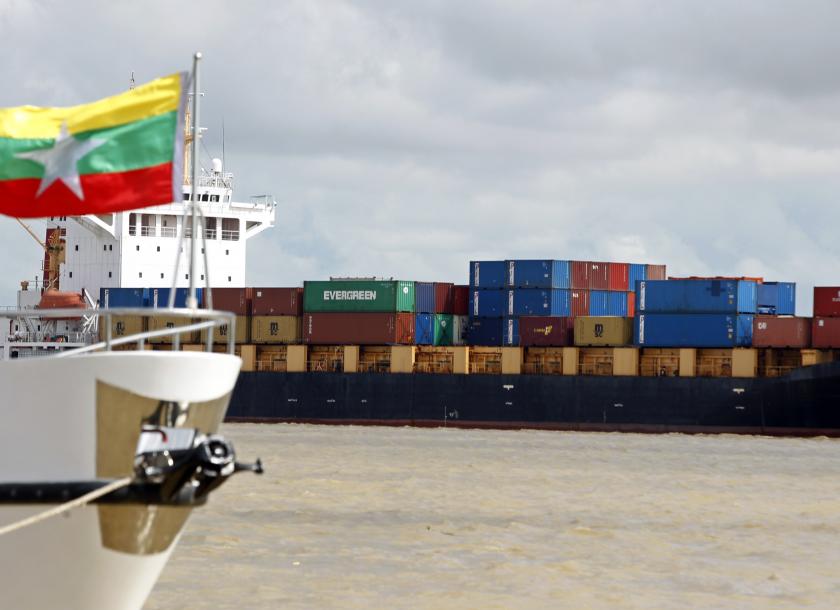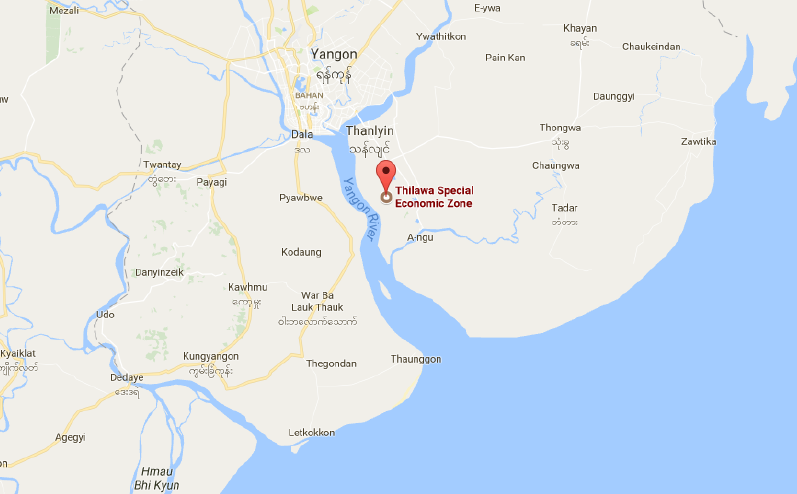Myanmar: Yangon’s growing trade demands deeper port to ease logistics woes
A DEEP-SEA port with access to the commercial capital should be built to cater for significant volume increase in trade if Myanmar aspires to develop into a competitive import-export economy, logistics businesses from the European and Japanese chambers told The Myanmar Times.
European logistics businesses have called for a deeper port to be constructed in Yangon’s delta region, but previous studies concluded that such undertaking would be difficult, a Japanese logistics expert cautioned.
According to a report by the European Chamber of Commerce in Myanmar (EuroCham), the lack of port infrastructure and congestion present a significant constraint for sea trade. It called for the establishment of a deep-sea port together with a Special Economic Zone (SEZ) at the delta region in order for the country to realise its geographical advantage and become a logistics hub in Asia.
Members of the EuroCham logistics advocacy group include Maersk Line Myanmar, Santa Fe Mobility Services, Dextra Transport, Damco Logistics Myanmar, Kuehne + Nagel, Rhenus Myanmar, Royal Haskoning DHV, Myanmar DHL and CMA CGM.
“The existing facilities of ports are questionable for the traders as there have been serious port congestion problems at the terminals in the past. For the time being, the current main terminals are all river terminals which means that shipping lines are unable to bring in larger-sized vessels,” the report stated. It recommended that a feasibility study on the construction of the port be conducted within 12 months.
Sea port vital for economy
Tatsuya Ueki, head of MOL (Mitsui OSK Lines) in Myanmar and chair of the logistics group under the Japan Chamber of Commerce and Industry in Myanmar (JCCM), agreed that Myanmar’s economy needs a deep-sea port.
“Without a deep-sea port, a country cannot grow its economy if we take a long-term view – let’s say 10 or 20 years. For the next five to 10 years, Thilawa Port [TP] will remain very important, but that has its limitations,” he told The Myanmar Times.
“Myanmar just opened up its economy to the international community. At this initial stage, TP is strategically important and MOL supports this Thilawa project. This is why we have been using TP extensively. However, in 10 or 15 years time, a deep-sea port will be vital for economic growth.
“I am interested in the EuroCham’s idea of having a deep-sea port at the delta region. The question is the location of the port as well as when and how the project will be implemented,” he added.
“Many specialist consultants have conducted feasibility studies regarding a deep-sea port at the delta region. But they said that technically and due to natural factors, building a deep-sea port will be difficult,” he suggested.
Port location
The deep-sea port will be located in the area where Yangon River meets the Gulf of Martaban. Whether the port will be constructed on Thilawa’s side or the opposite has been a subject of intense interest among investors, particularly those based in Thilawa SEZ, which is the country’s only SEZ in operation. Thilawa SEZ covers Kyauktan and Thanlyin townships, 25 kilometres south of Yangon city and situated on the east side of Yangon River. The other two SEZs, in Kyaukphyu and Dawei, are still at the planning stage.
The deep-sea port will be located in the area where Yangon River meets the Gulf of Martaban. Map: Google Map
The EuroCham advocacy group brushed off the view that the port location will directly determine the competitiveness of existing and planned SEZs and industrial zones.
“This [the port location] very much depends on the feasibility study and the infrastructure development plans of connecting factories and warehouses to the deep-sea port. The key is to make sure there is convenient connectivity to that location.
“The distance of the potential deep-sea port is far enough from the current industrial zones, factories and warehouses that the side of the river of the deep-sea port does not have extreme relevance if there is convenient bridges and roads for access to the port,” chief representatives of the group explained.
The estimated throughput of the port depends on many variable factors, for example, market developments, infrastructure and connectivity, according to the group. Assuming all things were in place and Myanmar’s markets continue to develop in a positive trend similar to its neighbours, a sea port should be planned for long-term growth.
For example, Laem Chabang Port in Thailand has various phases. The first phase has an annual throughput of 4.3 million TEUs (Twenty Foot Equivalent Unit, the unit of capacity of a container ship or terminal) in 2016; the second one with a capacity of 6.8 million TEUs though, in 2016, it had merely 1 million TEUs throughput.
“Hence, if Myanmar aspires to become a contending import/export country the deep-sea port should be planned for significant volume increase with a plan for future expansion,” they noted.
“For Myanmar, the first deep-sea port phase can be around the 2-3 million TEUs mark with options of expansion since we still have the river terminals and MITT terminal that will still play a dominant role for the foreseeable future.
“Vessel sizes are increasing due to the need to lower slots costs. The current biggest size is 21,000+ TEUs and soon to reach 22,000 TEUs.
“However, for Myanmar the current largest vessel size is only 1600 TEUs due to both market demand and the river limitation of draft and LOA restrictions [vessel length overall].
“So it’s a very long way for Myanmar to go but we can target to have 8,000 TEUs vessel size for Myanmar for the deep-sea ports for the first phase with options of accommodating larger vessel sizes if the demand of the market is there,” EuroCham said.
Yangon River has a depth of 9 metres, allowing vessels of more than 1,000 TEUs, whereas the delta region has a depth of 10 metres with a potential capacity for 2,000 TEU vessels. The latter is still significantly shallower than other deep-sea ports in the region, with some catering for 5,000 or even more than 10,000 TEUs.
SEZ appended
The group added that an SEZ within the vicinity of the port will reduce logistics and operational costs.
“Usually deep-sea ports tend to be further out which means that SEZ brings the manufacturing and warehousing closer to the deep-sea port locations. SEZ helps reduce tax costs, logistics costs and general operational costs. Hence, developing an SEZ along with and to support the deep-sea port will be ideal.”
The advocacy group observed that for the sea port to hit the competitiveness of the existing Yangon and Thilawa ports, it will be “something very far out into the future”.
“Theoretically, if the deep-sea port manages to become the main port for Myanmar with the proper infrastructure developments and [to become financially] more attractive to different companies then the river ports should have less competitiveness.
“However, it will be something very far out into the future and until then the river terminals and MITT will still be the main players.”
Sean Bain, legal consultant from the International Commission of Jurists (ICJ) in Myanmar, cautioned the government against shouldering risks brought by another SEZ project. Instead, the administration should address rights issues and update the legal framework.
“The government would be wise to address human rights and environmental concerns linked to existing SEZs, rather than taking on the risks and burdens of additional projects.
“Responsible businesses are now wary of investing in Myanmar’s SEZs because of their problematic legal framework and association with rights violations,” he told The Myanmar Times.
At present, the country has no deep-sea ports. However, there are plans to build one in Kyaukphyu, Pathein and Dawei.
Source: https://www.mmtimes.com/news/yangons-growing-trade-demands-deeper-port-ease-logistics-woes.html


 English
English





